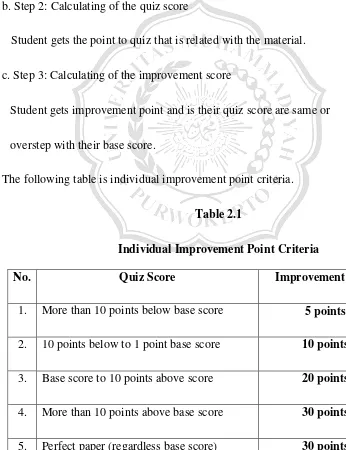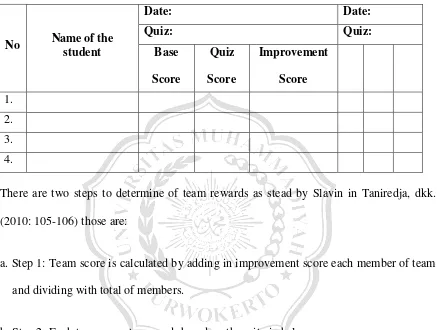CHAPTER II
THEORITICAL REVIEW
A. Reading
1. Definition of Reading
In every life, reading is one of the important skills of learning a second or foreign
language because through reading the students or the readers can improve their knowledge and get new information which can explore their competence. Besides that,
reading is part of the language acquisition. Some language experts shared their opinions on reading.
Descant in Leu (1987: 9) stated that reading is more complex: “reading can not occur
unless the pupil can identify and recognize the printed symbol and generally the pupil must also give the visual configuration a name”. Even so, it is only one aspect of the
reading process. Meaning too, is an absolute exquisite reading. Perhaps too much emphasis in reading instruction has been placed word identification and not enough comprehension.
Reading is a psycholinguistic guessing game. It involves an interaction between thought and language. Efficient reading does not result from precise perception and
identification of all elements, but from skill in selecting the fewest, most productive guess necessary to produce guesses (about meaning) which are right the first time. (Goodman in Leu, 1987: 9)
a definite idea about the author's intended message and a skill reader must be able to make use of sensory, syntactic, semantic and pragmatic information to accomplish his
task. These various sources of information interact in many complex ways during the process of reading.
According to Leu (1987: 9) reading is developmental, interactive and global process involving learned skill. The process specifically incorporates an individual's linguistic knowledge and can be both positively and negatively influenced by nonlinguistic internal
and external variables or factors.
Based on the definition above, the writer can conclude that reading is a process of understanding written language.
2. The Importance of Reading
Reading is one of the important aspects for the students, especially in English. From reading the students can get many information and knowledge. There are many books to
support their reading habit therefore; some of the students will feel difficulty to understand of the books that are written in English Ramelan (1990: 1) stated that:
Reading plays very important parts in our life. Through reading we canexplore the world, countries that have never been visited before, and the minds and ideas of great people in the past, all of which will enrich our experience and knowledge and broaden
our horizon. To a student, reading is also something crucial and indispensable since the success of their study depends for the greater part on his ability to read. If their reading skill is poor they are very likely to fail in their study or at least they will have difficulty
making progress. On the other hand, if he or she has a good reading ability, he or she will
As the students who study English lesson, reading is one of the important skills, because the students will explore much information, knowledge from reading activity.
Besides that, it can give more vocabularies to the students.
3. The Purpose of Reading
The purpose of reading is looking for and getting information from books,
references, texts or others. By reading, students are able to explore their knowledge well. According to Anderson (1972: 10) there are some purpose of reading, those are:
a. Reading for details or fact
The students read the text to get detail information of text or know the inversion that
have been done by the writer or solve the problem of the writer.
b. Reading for main idea
The students read the text (books) to know why the topic is good or interesting, find the
problems on the passage and make summaries of the passage.
c. Reading for sequence or reorganization
The students read the text to know what is happening in each part of the passage in
every episode and also solved the problem of the text.
d. Reading for inference
The students read the text in order to find out the conclusion from the action or idea in the text.
The students read the text to classify some information or actions of the writer in the text or paragraph.
f. Reading to evaluate
The students read the text to find out the characteristic of each character then evaluate them, either the characteristic can be imitated or not and the student tries to evaluate the
writer has done or what he tries to explain or contrast.
g. Reading to compare or contrast
The students read to compare the plot of the text or content that having similarity with the readers or even contrast.
B. Reading Comprehension
1. Definition of Reading Comprehension
Reading comprehension is reading with understand or silent reading. The aim is to get information, to understand and to draw something from the text. The primary purpose
of reading comprehension is to improve the students‟ ability to understand English as it is used in written material.
Nuttal defines reading comprehension just as it quoted in Anton (1995: 24) as follow.
“Reading comprehension means reading comprehension lesson that have traditionally
centered on a passage of the text followed by questions. Good question are the ones
which help readers to contribute actively to the process of making sense of it, rather than
expecting understanding just to happen”.
2. Major Components of Reading Comprehension
The more important things that need to be considered are the component of reading. The components of reading will support the success of understanding reading material
and contributing an important way to read. According to Leu (1987: 30-38) there are six components of reading, those are:
1. Decoding Knowledge
Knowledge is used to determine the oral equivalent of written word.
2. Vocabulary Knowledge
The knowledge one has about word meaning is used to determine the appropriate meaning for a word in particular context.
3. Discourse Knowledge
It is the knowledge of language organization at units beyond the single sentence level. It includes knowledge of structural organization of different type of writing.
4. Reading Aspect
Traditionally, it refers to the students‟ ability to benefit from initial reading
instruction. It also refers to the students‟ ability real and understands a particular
selection.
5. Affective Aspect
6. Syntactic Knowledge
The knowledge of the word order rules that determine the grammatical function and sometimes the meaning pronunciation of words.
The major components of reading influenced someone in comprehending the text. The readers have different interpretation on their understanding the text. The readers will
comprehend the text perfectly (it means that the reader understand what the writer means in the text) if the reader understand well of the major component of reading.
C. Number Head Together
1. Definition of Number Head Together
Number Head Together is one of the cooperative learning in structural method.
Cooperative learning type Number Head Together is developed by Kagen (1993). Generally, Number Head Together is used to involve the students in checking the
understanding of the students about the materials. According to Kagen (2007) cooperative learning type Number Head Together can help the students to share information, listening
accurately, and also speaking considerately. Lie (2008: 59) says that NHT is one of cooperative learning strategy. It gives opportunity to divide of the idea to another students and considering the correct answer. Group learning methods encourage students to take
greater responsibility for their own learning and to learn from one another. In Number Head Together, teacher divides the class into small groups, each group consists of 5-6 students and then teacher gives number for each group after that he or she
give some reading text and question that should be answered by each group. They are given the chance to give the answer of the question. Based on the answer, teacher can
2. Teaching Reading through Number Head Together Technique
Reading is one of the important things in learning English. It was support the teaching learning skills (speaking, reading, writing, and listening). The students have to
develop their understanding to find information and knowledge from the reading text. According to Trianto (2009: 82-83) there are some steps of Number Head Together technique in learning process, especially in reading material, those are:
a. Numbering
In this step, teacher divides the students into some groups, each group consists of 5-6 students and the teacher gives number series for the students in each groups.
b. Giving Question
Teacher gives question for each student. The question can be variation or same.
c. Thinking Together
After getting the question from teacher, the students think together to find the answer of
question and they should explain the answer for the members in their groups. So, all of members know the answer of each question.
d. Answering
Teacher calls one of the numbers. The students that have same number in each group should try to answer the question for the team. Then, teacher chooses the group that should answer the question randomly. The students that have same number in another
e. Evaluation
And the last step, teacher and students make a conclusion. Then, the teacher gives evaluation for the students.
Here are steps of the improvement point as stated by Slavin (1995).
a. Step 1: Determining of base score
Each student is given score based on the quiz score in the past.
b. Step 2: Calculating of the quiz score
Student gets the point to quiz that is related with the material.
c. Step 3: Calculating of the improvement score
Student gets improvement point and is their quiz score are same or
overstep with their base score.
The following table is individual improvement point criteria.
Table 2.1
Individual Improvement Point Criteria
No. Quiz Score Improvement Point
1. More than 10 points below base score 5 points
2. 10 points below to 1 point base score 10 points
3. Base score to 10 points above score 20 points
4. More than 10 points above base score 30 points
(Slavin, 2009: 159)
Whereas, scoring sheet of quiz can be seen in the following table:
Table 2.2
a. Step 1: Team score is calculated by adding in improvement score each member of team
and dividing with total of members.
b. Step 2: Each team accepts rewards based on the criteria below.
Table 2.3 (Team Rewards Criteria)
No Average Points Rewards
1 5-14 Points Good Team
2 15-24 Points Good Team
3 25-30 Points Good Team
3. The Advantage and Disadvantage of Number Head Together Technique
Number Head Together technique can make the students ready to do the task, give and answer question the students can discuss the material that is studied and there are
cooperation between the students who has more ability with student who has less ability. However, he also says that this technique is not suitable for the class that have many students because it needs much time and the teacher cannot call all of the members to
give or answer question. So, to solve the problem, the researcher should continue the discussion in next meeting.
The researcher concluded that Number Head Together is one of the alternative and interesting techniques in teaching learning process, because it makes students more active in discussion and also give students opportunity to deliver their opinion but the teachers
sometimes need much time to apply this technique.
D. Basic Assumption
The students felt that reading difficult lesson for them. Besides that, thestudents have
hunch that reading was very boring. So, to avoid those problems the teacherused cooperative learning type Number Head Together to teach reading because cooperative Number Head Together could make students more active and they felt more comfortable
to study. So, the researcher assumed that Number Head Together help the teacher to give
comfortable atmosphere for his or her students and it can improve students‟ reading

